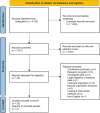How to tackle non-specific low back pain among adult patients? A systematic review with a meta-analysis to compare four interventions
- PMID: 38167170
- PMCID: PMC10763207
- DOI: 10.1186/s13018-023-04392-2
How to tackle non-specific low back pain among adult patients? A systematic review with a meta-analysis to compare four interventions
Abstract
Objective: To tackle non-specific low back pain (NSLBP) among patients and find the most effective solution and to quantitatively synthesize the overall effect of motor control training (MCT) compared with Pilates, McKenzie method, and physical therapy (PT) in pain and physical function.
Methods: Randomized controlled trials (RCTs) of four types of intervention (MCT, Pilates, McKenzie method, and PT) for LBP were collected by searching PubMed, Web of Science, EBSCOhost (Cochrane Central Register of Controlled Trials), and Scopus databases from the establishment of the database to September 30, 2023. The risk of bias was evaluated for included studies using the Revised Cochrane Risk of Bias tool for randomized trials (RoB 2.0). Taking pain and physical function in the experimental and control groups as outcome indicators, subgroup analysis was performed according to the intervention method to calculate the standardized mean difference (SMD) and 95% confidence interval (CI).
Results: A total of 25 RCTs, including 1253 patients, were included. Meta-analysis showed that MCT effectively relieved pain [SMD = -0.65, 95% CI (- 1.00, - 0.29), p < 0.01] and improved physical function [SMD = -0.76, 95% CI (- 1.22, - 0.31), p < 0.01] comparing with other 3 types of intervention. Subgroup analysis suggested that MCT could alleviate pain [SMD = -0.92, 95% CI (- 1.34, - 0.50), p < 0.01] and improve physical function [SMD = -1.15, 95% CI (- 1.72, - 0.57), p < 0.01] compared with PT, but it had no statistical significance compared with Pilates [pain: SMD = 0.13, 95% CI (- 0.56, 0.83), p = 0.71; physical function: SMD = 0.10, 95% CI (- 0.72, 0.91), p = 0.81] and the McKenzie method [pain: SMD = -0.03, 95% CI (- 0.75, 0.68), p = 0.93; physical function: SMD = -0.03, 95% CI (- 1.00, 0.94), p = 0.95].
Conclusions: MCT can effectively relieve pain and improve physical function in patients with NSLBP. It is more effective compared with PT for LBP, while no differences were detected between MCT and Pilates, as well as McKenzie method. Therefore, MCT, Pilates, and the McKenzie method should be encouraged as exercise interventions for NSLBP rehabilitation.
Keywords: McKenzie; Motor control training; Non-specific low back pain; Physical therapy; Pilates.
© 2023. The Author(s).
Conflict of interest statement
All authors have no conflicts of interest relevant to the content of this review.
Figures








Similar articles
-
Yoga compared to non-exercise or physical therapy exercise on pain, disability, and quality of life for patients with chronic low back pain: A systematic review and meta-analysis of randomized controlled trials.PLoS One. 2020 Sep 1;15(9):e0238544. doi: 10.1371/journal.pone.0238544. eCollection 2020. PLoS One. 2020. PMID: 32870936 Free PMC article.
-
Is immediate imaging important in managing low back pain?J Athl Train. 2011 Jan-Feb;46(1):99-102. doi: 10.4085/1062-6050-46.1.99. J Athl Train. 2011. PMID: 21214357 Free PMC article.
-
Whole Body Vibration Exercise for Chronic Musculoskeletal Pain: A Systematic Review and Meta-analysis of Randomized Controlled Trials.Arch Phys Med Rehabil. 2019 Nov;100(11):2167-2178. doi: 10.1016/j.apmr.2019.03.011. Epub 2019 Apr 17. Arch Phys Med Rehabil. 2019. PMID: 31004565
-
Systematic review and meta-analysis of effects of acupuncture on pain and function in non-specific low back pain.Acupunct Med. 2020 Aug;38(4):235-243. doi: 10.1136/acupmed-2017-011622. Epub 2020 May 27. Acupunct Med. 2020. PMID: 32458717
-
Therapeutic ultrasound for chronic low back pain.Cochrane Database Syst Rev. 2020 Jul 5;7(7):CD009169. doi: 10.1002/14651858.CD009169.pub3. Cochrane Database Syst Rev. 2020. PMID: 32623724 Free PMC article.
Cited by
-
Influence of preoperative medial meniscus extrusion and subchondral bone marrow edema on outcomes after medial opening wedge high tibial osteotomy.J Orthop Surg Res. 2025 Apr 9;20(1):353. doi: 10.1186/s13018-025-05656-9. J Orthop Surg Res. 2025. PMID: 40205393 Free PMC article.
-
Nail-plate combination versus single construct for the management of distal femoral fractures: a meta-analysis.Eur J Orthop Surg Traumatol. 2025 Mar 18;35(1):124. doi: 10.1007/s00590-025-04239-y. Eur J Orthop Surg Traumatol. 2025. PMID: 40100415 Review.
-
Ex vivo mechanical testing of double strand, braided and knitted polyethylene suture for acute transverse section of the Achilles tendon in a dog model.J Orthop Surg Res. 2025 May 30;20(1):545. doi: 10.1186/s13018-025-05947-1. J Orthop Surg Res. 2025. PMID: 40442722 Free PMC article.
References
-
- Collaborators GDaIIaP. Global, regional, and national incidence, prevalence, and years lived with disability for 354 diseases and injuries for 195 countries and territories, 1990–2017: a systematic analysis for the Global Burden of Disease Study 2017. Lancet. 2018;392(10159):1789–858. - PMC - PubMed
Publication types
MeSH terms
Grants and funding
LinkOut - more resources
Full Text Sources
Miscellaneous

